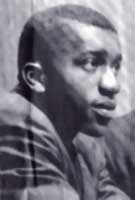1942-2006
Robert McCullough, civil rights organizer
By
Kathy Durkin
Published Aug 24, 2006 10:11 PM
|
18 year-old Robert McCullough.
|
On Aug. 7, Robert Louis McCullough died at the
age of 64 in Rock Hill, S.C., where as an African-American student organizer
during the 1960s, he helped to make history in a landmark struggle against
racism.
McCullough was born and raised in Rock Hill, a textile
manufacturing center near Charlotte. In 1957, two years after the historic
Montgomery bus boycott, the African-American community carried out the Rock Hill
bus boycott, which shut down that city’s segregated bus
company.
Inspired by the growing movement against racist Jim Crow laws and
practices in the South, African-American students held a historic sit-in at the
segregated Woolworth’s lunch counter in Greensboro, N.C. on February 1,
1960, followed by six months of protests which won desegregated lunch counters
there.
The Greensboro actions set off demonstrations all over the South,
including in Rock Hill, where Black students marched for a year along that
city’s Main Street.
Eleven days after the ground-breaking
Greensboro action, 100 African-American youth, mainly students at Friendship
Junior College, held the first South Carolina sit-ins at Rock Hill’s
Woolworth’s and McCrory’s lunch counters, followed by a year-long
campaign there.
McCullough helped to organize a key protest in Rock Hill.
His fellow student participants appointed him as their leader. As his fellow
activist David Williamson explained, “He did all the detail work and made
sure everything was in place.”
On January 31, 1961, 18-year-old
McCullough, along with eight other African-American students from Friend ship
and one civil rights organizer, sat in at the “whites-only” lunch
counter at McCrory’s. They demanded service, which they were denied.
Arrested and tried on the official charges of “trespassing”
and “breach of peace,” these courageous young men were guilty only
of seeking justice and an end to racist discrimination.
But these
activists brought a new tactic to this struggle. They pledged among themselves
to go to jail rather than pay fines or bail, which had been the practice of
previous sit-in protestors. When faced with paying a $100 fine each or 30-day
sentences at the York County Prison Farm with forced labor on a chain gang, nine
of them went to prison. That they faced imprisonment or fines for fighting for
justice was the real crime.
Racist prison officials saw to it that
McCullough and seven of his fellow activists served some time in solitary
confinement, where they subsisted on bread and water. The jailers were furious
that they refused orders to stop singing civil rights songs while daily loading
36 truckloads of dirt on the roadside chain gang.
“This was the
first time anyone had served full sentences in the sit-in movement,”
commented historian Howard Zinn.
The struggle of the Friendship Nine
proved to be a vital part of the civil rights movement and inspired many youth.
After their jailing, four Student Nonviolent Coordi nating Committee
(SNCC) organizers went to Rock Hill to be arrested in solidarity with them. They
sat in at McCrory’s, were arrested and imprisoned. Then 100 activists went
to jail in other cities, after similar anti-racist protests.
The
“Jail, No Bail” stand taken by the Friendship Nine “made
electrifying news” within the civil rights movement, wrote Taylor Branch
in “Parting the Waters: America in the King Years 1954-63.” Besides
putting political pressure on the racist power structure, it put financial
pressure on them as well. Branch explains that this tactic “obligated the
white authorities to pay for [protesters’] jail space and
food.”
Also significant was the press coverage, particularly in the
Baltimore Afro-American Newspaper, and the mass support mobilized for the
Friendship Nine. The African-American community organized big, rousing meetings.
Picketers lined the street outside McCrory’s. SNCC mobilized mass protests
bringing African-American students from other cities. Motorcades drove to the
prison farm. Protesters even went to Washington, D.C. Picketing continued in
Rock Hill for a month after the Nine were released.
Robert Louis
McCullough, whom fellow activists described as “our teacher” and
called “our general” because of his leadership and strategic skills,
left a legacy of struggle and courage. Upon his death, they recalled that he
said to them while planning their bold action in 1961, that they were doing it
“for all of humanity.” They also recollected that at a recent
Friendship Nine reunion he said to them, “If we had to do it again,
we’d do it again.”
The monumental civil rights struggle was
marked by great courage, boldness, organization, and untold sacrifices by many.
The Friendship Nine were a vital part of that history.
Sources for this
article include Student Non-Violent Coordinating Committee (SNCC) Timeline at
www.crmvet.org.
Articles copyright 1995-2012 Workers World.
Verbatim copying and distribution of this entire article is permitted in any medium without royalty provided this notice is preserved.
Workers World, 55 W. 17 St., NY, NY 10011
Email:
[email protected]
Subscribe
[email protected]
Support independent news
DONATE


